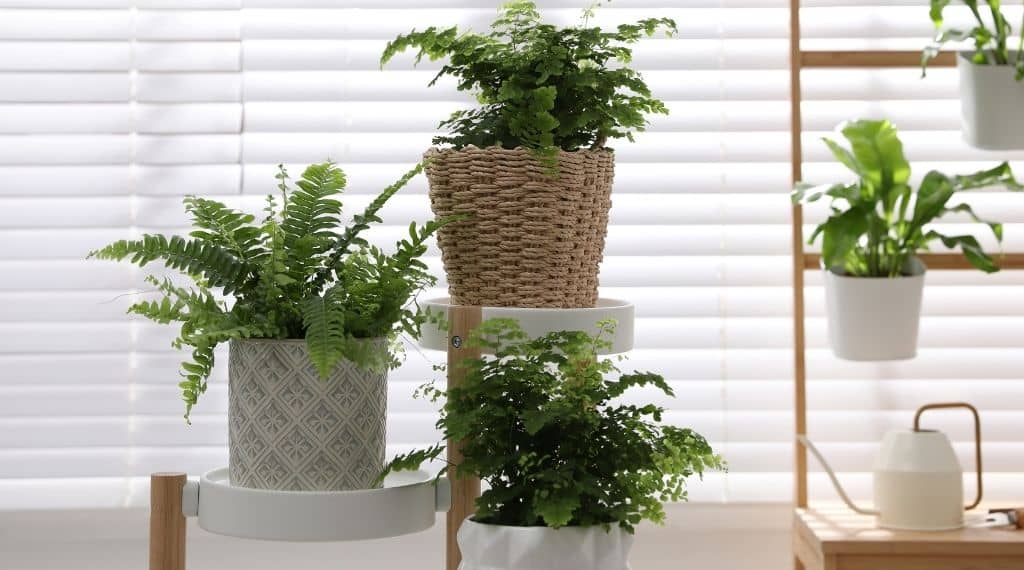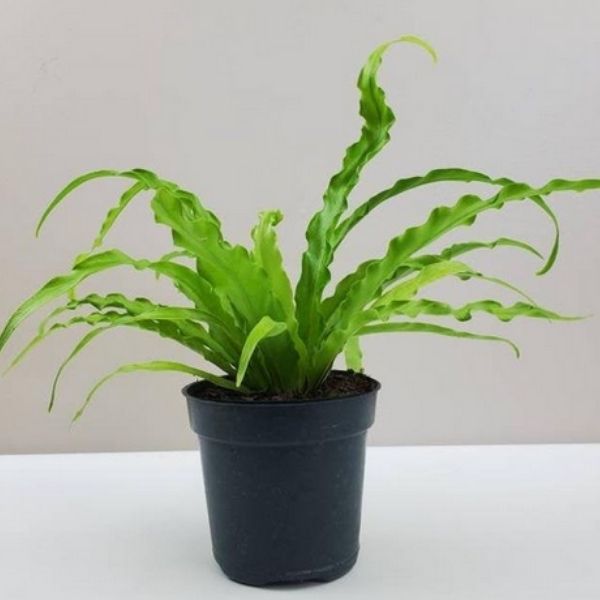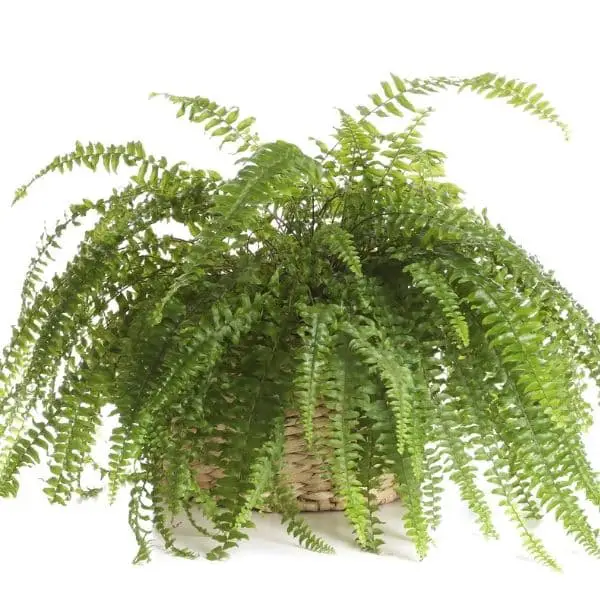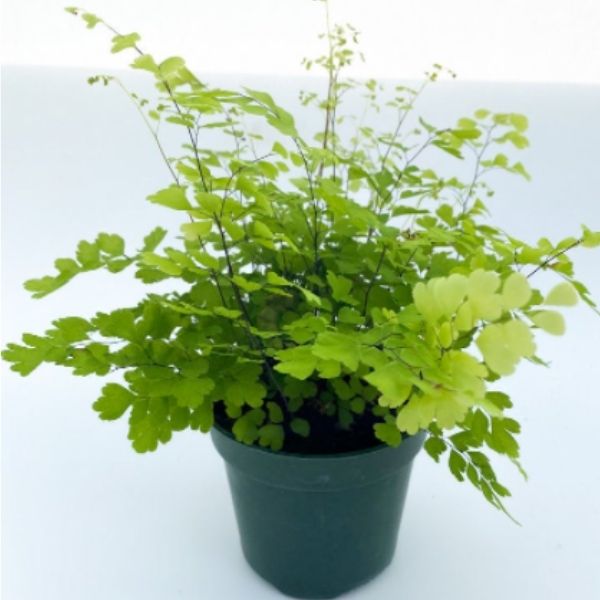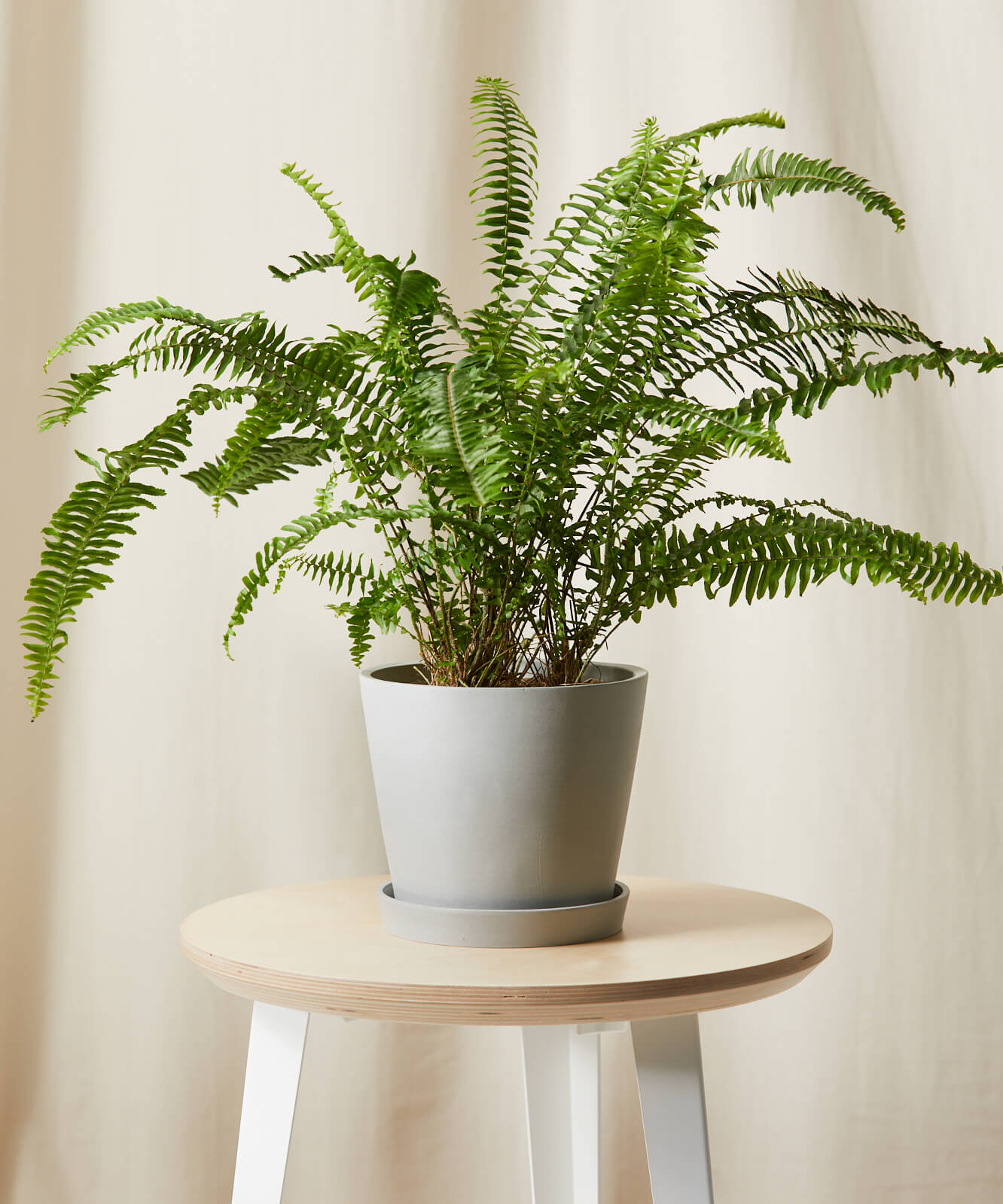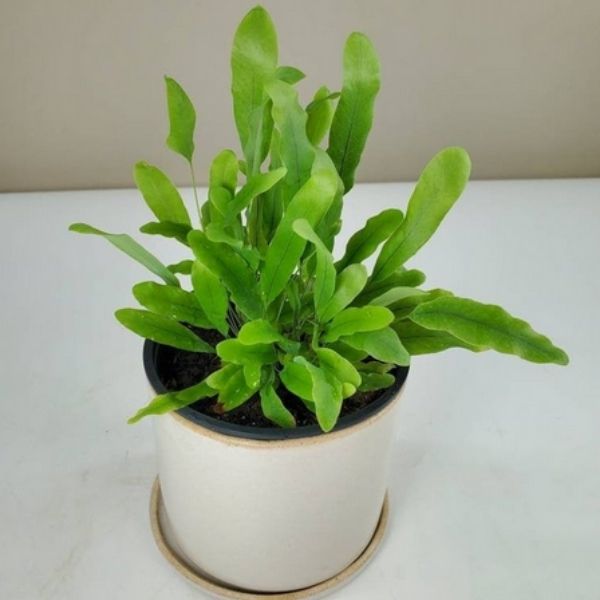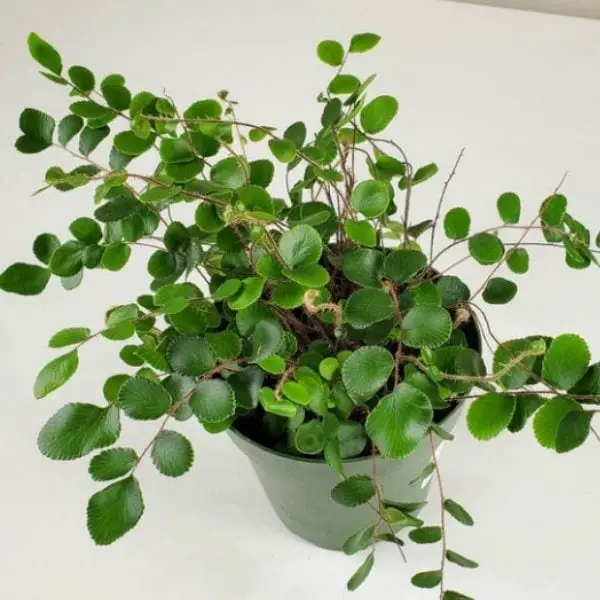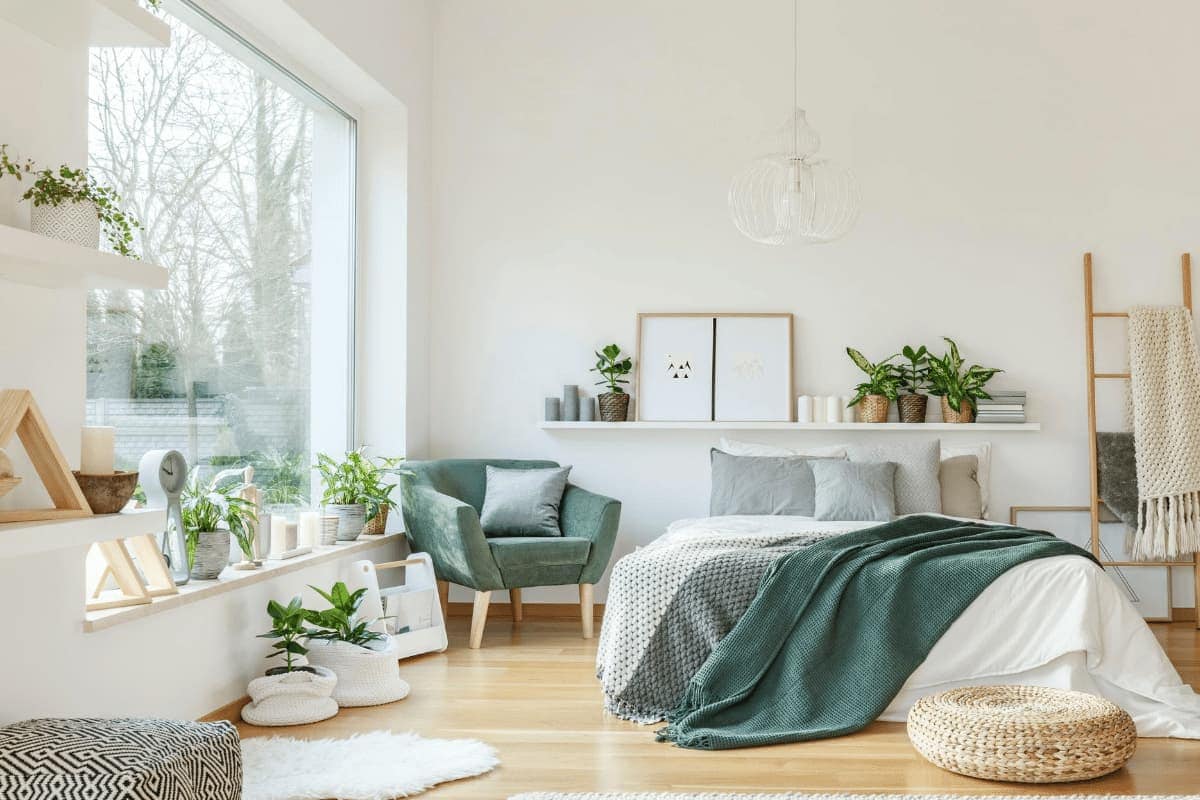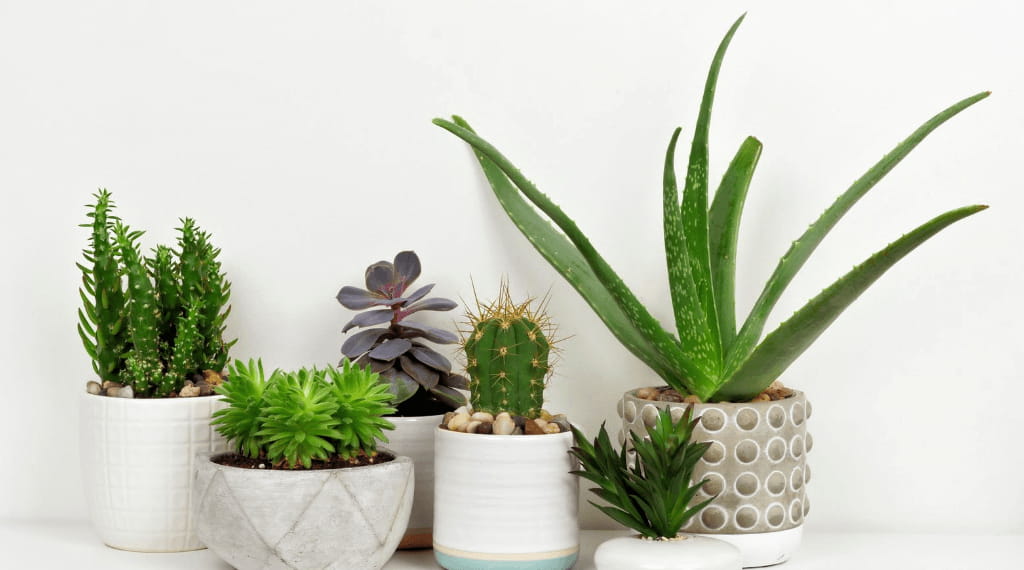Last Updated on October 9, 2021 by Plantiful Interiors
Types of Ferns For Indoors
There are many different types of ferns for indoors, and each has it’s own unique aesthetic appeal.
Ferns are a group of plants belonging to the class Polypodiopsida, and are often known for their ruffle type fronds or round button leaves.
According to a 1993 botanical study, certain fern species were found to remove harmful Volatile Organic Chemicals (VOCs) — like formaldehyde and xylene — from the air of enclosed spaces such as in homes; an excellent reason to include ferns in your home decor.
This post contains affiliate links. As an affiliate partner of various brands, we earn a little commission on qualifying purchases, at no extra cost to you. When you purchase through our links, you help our business to keep going. So thank you for your support! You may read our full disclaimer for more information.
Instead of producing seeds, fruit or flowers, ferns reproduce only by way of spores, which can be found on their frond-like leaves.
These fronds are called megaphylls, and in many fern species, start out as coils that unravel as they grow. Due to the fact that ferns are relatively easy to grow and maintain, they have become popular houseplants.
One key factor when caring for most different types of ferns for indoors is that they LOVE water. This means you’ll need to remember to water them regularly.
Some will even require misting in between watering, so if you’re a forgetful plant parent you may want to consider using a self-watering pot for your fern.
There are many different types of ferns for indoors, each requiring a slightly different care for optimal health.
This article will review different types of ferns for indoors, fern species, their unique features, and instructions for their care. We’ve also included some decor tips for where to place your indoor fern.
Types of Ferns For Indoors: Birds Nest Fern
The Bird’s Nest Fern (Asplenium nidus) is a broad-fronded tropical fern that is native to Eastern Africa, Southeast Asia, Australia, Hawaii, and Polynesia.
This fern is an epiphytic plant — meaning it naturally grows on the surfaces of other plants.
The Bird’s Nest Fern grows as a collection of large, wide fronds that emanate from a central rosette; they are said to resemble banana leaves.
At A Glance Care: Bird’s Nest Fern
Care Instructions
Although the Bird’s Nest Fern can survive in temperatures of around 50 degrees Fahrenheit, it does much better in steadier higher temperatures of around 60 to 80 degrees Fahrenheit.
This fern thrives best with soil that is only moderately moist.
The Bird’s Nest does best in indirect sunlight with some areas of shade. It is not a direct-sunlight plant, so putting it in a southern or western-facing window is a bad idea (try the north or east).
The Bird’s Nest Fern must be fertilized ideally once a month during its growing season (from April through the month of September).
Use half-diluted liquid fertilizer on the fern’s soil and do not put the fertilizer directly on the plant. Fertilizer is unnecessary outside of this season.
Bird’s Nest Fern soil should be relatively loose and full of organic matter. A peat-based soil potting mix is recommended.
After about 2 or 3 years of steady growth you will need to consider replanting your fern to allow room for its long spreading fronds.
Where To Place In Home
Avoid placing the Bird’s Nest Fern in rooms that are known to be cooler or near any drafty windows and doors.
This plant does best from a consistently warm, humid area like a bathroom — or a warm room accompanied by a humidifier.
Keep this fern out of direct sunlight and try to aim for rooms with northern or eastern-facing windows.
Though the Bird’s Nest Fern isn’t toxic so you won’t have to worry about placing it out of reach for paws or little hands.
Types of Ferns For Indoors: Staghorn Fern
The Staghorn Fern refers to several plants of the genus Platycerium. Among them is the popular Platycerium bifurcatum, or Common Staghorn Fern, which is native to Australia, Indonesia, and New Guinea.
The Staghorn Fern has two types of fronds: Antler fronds and Shield fronds.
Antler fronds are thin, high-reaching fronds that resemble deer antlers, while Shield fronds are rounder, heartier fronds that jut out from the plant’s root ball.
The Staghorn Fern is frequently placed on wood planks and mounted onto walls.
At A Glance Care: The Staghorn Fern
Care Instructions
Staghorn ferns thrive in high-temperature areas with a lot of humidity. This means a range of temperatures from 50 to 100 degrees Fahrenheit, with consistent temperatures toward the higher end of that range.
Staghorn Ferns need to be misted and soaked in water. This fern needs a consistent, albeit shaded source of light.
It does not do well in direct sunlight as its leaves can burn easily. That said, consistently higher temperatures and humidity allow for a heartier plant.
You should fertilize this fern monthly in the spring and summer, and every other month in the fall and winter. Staghorn Ferns are susceptible to spider mites and can be treated with neem oil.
Keep this plant in a high-temperature (the higher the better) humid room, or a room with a humidifier.
To propagate this plant, divide a mature frond from the root ball, with some of the root ball intact. Keep moist and mount elsewhere.
Where To Place In Home
The unique benefit of the Staghorn Fern is that it does not need to be planted in a pot. A stylish way to display your Staghorn Fern is by mounting it onto a piece of wood and hung on the wall.
Preferably on a western wall near a window so that it can get adequate morning light and not be overwhelmed by the afternoon sun.
Check out this simple video tutorial to learn how to mount your own Staghorn Fern in under 5 minutes.
Types of Ferns For Indoors: Boston Fern
The Boston Fern (Nephrolepis exaltata) is also known as the Sword Fern is usually the most common type of fern that people think of. This type of fern is native to Central and South America, the Caribbean, Africa, and Polynesia.
You can identify a Boston Fern by it’s long (20 to 98 inch) fronds that are covered in small (0.79 to 3.15 inch), triangular “leaflets” and begin to arch as the plant ages.
At A Glance Care: The Boston Fern
Care Instructions
The Boston Fern needs to be kept in rooms where temperatures are steadily between 65 and 75 degrees Fahrenheit.
As with many ferns, Boston Ferns love humidity and will thrive if the humidity level in the room is around 80 percent.
Try placing it in a room that where it will get a moderate amount of indirect sunlight. Keep the soil moist at all times to avoid the leaves from drying out and falling off.
Your Boston Fern should be fertilized with a half-strength fertilizer monthly in the spring and summer months for optimal growth. Fertilizer is unnecessary in fall and winter when the plant’s growth is slowed.
The Boston Fern needs a pot with a lot of drainage holes; it should be re-potted once roots are visible from the soil.
To propagate this plant, you must divide healthy mature leaves from the main plant with a small portion of the root ball attached.
Where To Place In Home
Place the Boston Fern in a humid area of your home with a moderate (65 to 75 Fahrenheit) temperature. Place it by a window where it can be exposed to light bouncing off of walls and floors.
We love the way these plants look placed in an old fashioned wicker basket where it’s fronds can arch over the basket, reminding us of our Grandmother’s homes.
Check out this retro Kouboo Rattan Planter Basket available from Amazon. Since you will need to mist it regularly, it’s not ideal to hang it where it would be difficult to get to.
Types Of Ferns For Indoors: Care + Must Haves
Types of Ferns For Indoors: Maidenhair Fern
The Maidenhair Fern refers to ferns of the genus Adiantum. This is a group of some 200 fern species, with leaf morphology ranging from fan-shaped to longer, feather-shaped types.
The common property of this genus, however, is the ability of the frond leaves to repel water.
At A Glance Care: Maidenhair Fern
Care Instructions
The Maidenhair Fern is best kept at temperatures above 70 degrees Fahrenheit, and should not be in room where temperatures drop below 60 degrees or have drafty areas.
This type of fern is known to be one of the hardest ferns to overwater. It is a moisture-loving plant that needs to be misted several times a day or placed in a room with a humidifier.
An excellent choice to place in a self-watering pot. If you let your Maidenhair dry out, it will die very quickly.
This fern needs be planted in soil that can remain consistently moist and is rich in compost. Plant your Maidenhair in a pot that has many drainage holes.
Then place it close to an area where it will get bright indirect light
When repotting, you can divide the plant into sections of fronds that include the root; you can then plant these sections each in their own pot.
Don’t be alarmed if your Maidenhair Fern isn’t growing quickly, they are known for their slow growth and can take a couple of year to reach maturity.
Where To Place In Home
These plants thrive in bathrooms as they love humidity but will not do well in a bathroom with no windows or where it would get very little light.
Try a hanging basked directly in front of the window. This type of fern tends to stay under 2 feet in length and height so it shouldn’t overpower your room.
If you do not want this plant in your bathroom, your Maidenhair Fern should be placed in a warm, humid room with a large space of indirect sunlight.
A north facing window will provide ideal sunlight conditions. Keep in mind that the bright sunlight will dry out your soil so you’ll need to check on it every couple of days and mist regularly.
Types of Ferns For Indoors: Kimberley Queen Fern
The Kimberly Queen Fern (Nephrolepis obliterata) is a species of fern that is native to Australia. It has long arching fronds with shiny, green, ruffle-shaped leaves that look look full and stunning indoors.
This fast easy to grow plant thrives in humid environments and is excellent for cleansing toxins from the air in your home.
Care Instructions
The Kimberly Queen Fern is best kept at temperatures between 60 to 75 degrees Fahrenheit. It requires consistently moist soil, and soil should not be allowed to dry out completely.
This is one of few plants that can tolerate bright direct sunlight but it’s still recommended to place it where it will get indirect sunlight so as to not allow it to dry out too quickly.
To help keep the leaves of your Kimberley Queen Fern lush and colorful and it’s roots strong and healthy, fertilize your fern monthly with a balanced liquid fertilizer during it’s peak growing season.
Where To Place In Home/Benefits
The Kimberly Queen Fern should be in a high-humidity area or where it can be misted daily. This fern looks stunning planted in a colorful pot.
You can place on an end table or hallway entrance table where it will make a bold statement. Keep your Kimberly Queen Fern away from fireplaces where the air could be too dry.
Types of Ferns For Indoors: Lemon Button Fern
The Lemon Button Fern (species Nephrolepis cordifolia) is a relatively small-leaved fern with a distinguishing citrus scent that emanates when handled.
Lemon Button Ferns are one of the easiest types of ferns to grow, making them perfect for beginner plant parents.
At A Glance Care: Lemon Button Fern
Care Instructions
The Lemon Button Fern should be kept at temperatures between 60 and 70 degrees Fahrenheit. It does best in rooms with humidifiers.
As with many ferns, you’ll need to mist your Lemon Button fern regular throughout the week. When the top 1/2 – 1 inch of soil is dry, give it a good soaking.
This type of fern loves to stay moist. Ensure the pot you use has good drainage holes as to not hold the water causing the water and roots to become soggy.
Avoid using terra-cotta pots as they are known to draw water out of the soil which could leave your fern drying out too quickly.
Where To Place In Home/Benefits
This fern is one of the smaller types of ferns and looks stunning in a hanging pot near a window where it can get a moderate amount of indirect sunlight.
Ensure that it does not get direct afternoon sun or you could risk damaging the fronds. Keep in mind, you will need to mist and water regularly so hang it in an area that is easy to get to.
This courier metal hanging planter from Wayfair is versatile and can be hung near a window or thanks to its flat bottom if you can sit it on a coffee or end table if you prefer.
Types of Ferns For Indoors: Silver Lace Fern
The Silver Lace Fern (Pteris ensiformis) is native to the Pacific region and Asia. This type of fern can easily be identified by it’s flat variegated leaves that display a white-silver color throughout the leaves that branch out in a feather-like way.
At A Glance Care: Silver Lace Fern
Care Instructions
Chose a well-draining potting soil with a peat-moss base and use a pot with drain holes to help keep the soil moist but prevent it from becoming soggy.
If you notice your fern is drooping it could be due to overwatering, allow the soil to dry out a bit before watering.
Place in a room where day time temperatures are steady between 65 to 75 degrees Fahrenheit. If you tend to allow for cooler temps in your home throughout the night this fern will withstand temperatures as low as 55 degrees Fahrenheit for such temporary periods.
Though the Silver Lace Fern does well when fed a diluted (follow instructions on box) houseplant fertilizer during the spring and summer months, it does not require fertilizer from October to March when it’s growth cycle has slowed naturally.
Where To Place In Home/Benefits
The Silver Lace Fern likes a mixture of brights indirect sun as well as shade. Placing it in a north-facing window should provide adequate lighting conditions.
Due to its aesthetic appeal, this fern deserves an elegant pot that showcases it’s natural beauty. This globe shaped pot complimented by it’s brass holder is a stunning match for the Silver Lace Fern.
Something about this plant just screams “welcome” which is why we love it displayed just inside an entry way where guests can admire its beauty.
You May Also Enjoy: Aesthetic Plants: Beautiful Indoor Plants for Home Decor
Types of Ferns For Indoors: Blue Star Fern
The Blue Star Fern (species Phlebodium aureum) is a fern native to the tropical regions of the Americas and is distinguished by its flat, blueish-grey fronds which grow upwards.
At A Glance Care: Blue Star Fern
Care Instructions
The Blue Star Fern should be planted in loose soil that can drain freely, it may be helpful to add some perlite to your soil to assist with drainage.
Opt for a plastic pot with drainage holes as to not allow for standing water.
Although this fern can withstand drying out every now and again, it’s advised to keep the soil consistently moist.
Reach your finger into the soil, or use a moisture meter, to check the dampness of the soil at the half way mark. If the top half of the soil is dry, it’s time to water.
Remove any brown tips that appear on your fern’s fronds to keep it healthy and encourage growth.
Where To Place In Home
Due to it’s upward growth and ability to tolerate lower light conditions, the Blue Star Fern looks stunning placed on the bottom shelf of tiered plant stand or on a hallway table where it will get some indirect light and welcome your guests with it’s unique color and shape.
Types of Ferns For Indoors: Button Fern
The Button Fern (Pellae rotundifolia), not to be confused with the Lemon Button Fern mentioned earlier, is native to New Zealand.
It has long (18-inch) fronds and can be identified by it’s small, round, leathery leaves which attach to thin stems.
An identifiable trait of the Button Fern is that as the plant ages the stems turn a dark red and leaves become more round.
At A Glance Care: Button Fern
Care Instructions
Keep this fern away from any drafty windows, doors or vents in rooms with regular temperatures between 60 to 75 degrees Fahrenheit.
Your Button Fern will do best in moist, but not soggy soil. Give your Button Fern a good soaking when the top 1 inch of soil is dry.
Be sure to plant your Button Fern in a pot that has drainage holes; although these plants love water you still need to be careful to no overwater.
You can feed your Button Fern with diluted liquid fertilizer monthly through Spring in Summer during it’s peak growing season.
But do not feed it during winter months when the growth period is naturally slowed.
Where To Place In Home
The Button Fern looks stunning planted in a simple modern white ceramic pot and hung from the ceiling with in a macrame hanger. Hang it the corner of a master bath where it will draw humidity from the shower.
Types of Ferns For Indoors: Austral Gem Fern
The Austral Gem Fern (Asplenium dimorphum x difforme) is an evergreen hybrid fern that originated in Australia.
It has distinct, somewhat oak-shaped leaves and stems that are waxy and stern which can sometimes make the plant look artificial.
At A Glance Care: Austral Gem Fern
Care Instructions
Of all the different types of ferns for indoors discussed in this article, the Austral Gem Fern is the go to fern for those who have a hard time sticking to a consistent watering schedule.
With that being said, this type of fern still prefers its soil to be kept moist but it doesn’t die as quickly as others if left to dry out or if placed in a room where humidity levels are slightly lower.
The Austral Gem Fern does well in low to medium light conditions which is another factor in making it an easy to grow fern.
Room temperature is perfect for this plant in an area will it will not be hit with direct sunlight that could damage it’s fronds.
Where To Place In Home/Benefits
The Austral Gem Fern looks charming placed on a plant stand or hanging in a basket where it can be a focal point.
Due to its ability to tolerate low to medium light conditions the opportunities of which room to place in your home are almost endless.
Try adding it to a room where plants that require more sunlight wouldn’t do well such as a recreational room or hallway.
Wrapping Up Types of Ferns For Indoors
There are so many different types of ferns for indoors to choose from, the 10 listed in this article are just a few of them.
Ferns come in all different shapes and sizes colors, and even smells that you’re sure to be able to find one that would make a wonderful addition to your home decor.
With the fern care guides included in this post, as well as the tips on where to place each fern in your home, hopefully you’ll be able to keep your fern alive and healthy for years to come.
Drop a comment below and let me know which fern you’ve decided to include in your home.

